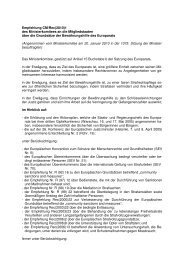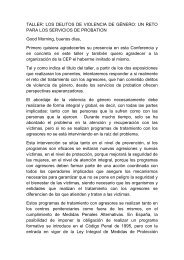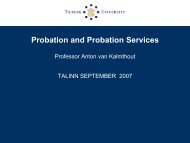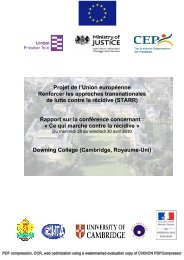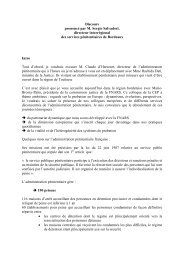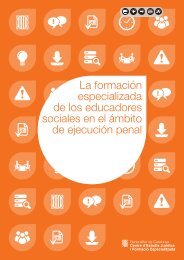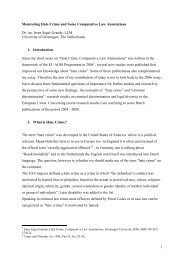Report EM 2005 - E - CEP, the European Organisation for Probation
Report EM 2005 - E - CEP, the European Organisation for Probation
Report EM 2005 - E - CEP, the European Organisation for Probation
Create successful ePaper yourself
Turn your PDF publications into a flip-book with our unique Google optimized e-Paper software.
complicated concept to analyse and measure). There seemed to be a consensus that<br />
where <strong>EM</strong> had been used to facilitate release from prison, costs were coming down;<br />
where it was used as a community sanction <strong>the</strong> cost-implications were less clear. There<br />
was some evidence that <strong>EM</strong> did reduce <strong>the</strong> use of imprisonment, but this was not<br />
evidence that net-widening never occurred.<br />
Among his general conclusions, Professor Albrecht argued that <strong>the</strong> diversity apparent in<br />
<strong>the</strong> use of <strong>EM</strong> across Europe reflected <strong>the</strong> diversity of <strong>European</strong> criminal justice systems<br />
in general. He anticipated that while change of some sort would be constant in <strong>the</strong>se<br />
systems, sometimes in <strong>the</strong> direction of harmonisation, this diversity, reflecting historical<br />
traditions and country-specific problems, would continue <strong>for</strong> <strong>the</strong> <strong>for</strong>eseeable future. <strong>EM</strong><br />
would be used to address particular issues in particular jurisdictions. Countries would<br />
none<strong>the</strong>less be prepared to learn from each o<strong>the</strong>r’s experience of <strong>EM</strong>, as with o<strong>the</strong>r<br />
penalties and sanctions.<br />
3.2 Electronic Monitoring in <strong>the</strong> USA<br />
Peggy Conway, consultant to <strong>the</strong> <strong>EM</strong> industry, and editor of <strong>the</strong> Journal of Offender<br />
Monitoring<br />
Peggy Conway gave a necessarily brief account of <strong>the</strong> development of <strong>EM</strong> in <strong>the</strong> USA,<br />
pointing out that because of <strong>the</strong> largely federated nature of American criminal justice –<br />
its variation across 50 different states – it was impossible to generalise about any<br />
development in criminal justice. <strong>EM</strong> was no exception. In addition, no one agency in <strong>the</strong><br />
US had responsibility <strong>for</strong> maintaining an overview of how <strong>EM</strong> had developed, and what<br />
<strong>the</strong> trends and directions were. Far less systematic evaluative research had been done<br />
on <strong>EM</strong> in <strong>the</strong> US than seemed to have been done in Europe. Much had indeed been<br />
written on <strong>EM</strong> in <strong>the</strong> US, but <strong>the</strong>re was far less integration of researchers and policymakers<br />
<strong>the</strong>re than here.<br />
In Ms Conway’s estimation, <strong>the</strong> first wave of <strong>EM</strong>’s development had been dominated by<br />
pre-trial schemes. Latterly, <strong>the</strong>re had been an emphasis on “re-entry schemes” – release<br />
from prison schemes linked to parole. This wave of development was largely due to fiscal<br />
considerations affecting many states. The mass use of imprisonment was deemed to be<br />
too expensive. Policy-makers were looking <strong>for</strong> ways to pare down <strong>the</strong> cost of<br />
imprisonment and early release programmes were seen as one way of doing this – as<br />
well as making <strong>the</strong> release process seem tougher – without conceding to <strong>the</strong> public that<br />
prison was being overused. It was mostly in <strong>the</strong> re-entry market that GPS satellite<br />
tracking had taken off. Compared to what she had picked up about Europe, <strong>the</strong>re was no<br />
official talk in <strong>the</strong> USA of needing to reduce prison populations, and no attempt to<br />
conceive of <strong>EM</strong> as an alternative to prison.<br />
The pattern of <strong>EM</strong>’s development in <strong>the</strong> USA had been significantly affected by vendors –<br />
some aggressive marketing had undoubtedly occurred. The end result had not, however,<br />
made a great deal of difference to American penal practice, which had been dominated<br />
by imprisonment. The American <strong>Probation</strong> and Parole Association had also promoted <strong>EM</strong><br />
and did have some ownership of it as a probation tool. Its website was a useful source of<br />
4


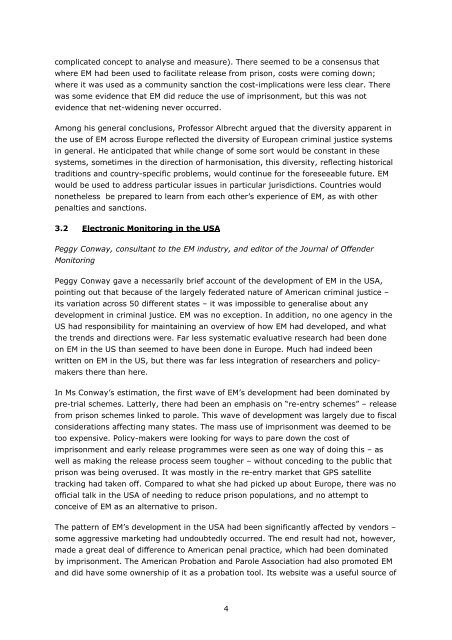

![AGIS2 Nov 08 Conference Report_[Version 2] - CEP, the European ...](https://img.yumpu.com/50764570/1/190x245/agis2-nov-08-conference-report-version-2-cep-the-european-.jpg?quality=85)
